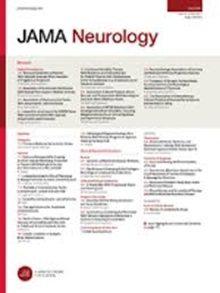Long-Term Personalized Adaptive Deep Brain Stimulation in Parkinson Disease: A Nonrandomized Clinical Trial.
IF 21.3
1区 医学
Q1 CLINICAL NEUROLOGY
引用次数: 0
Abstract
Importance Adaptive deep brain stimulation (aDBS) automatically adjusts stimulation amplitude in response to changes in relevant neural activity in people with Parkinson disease (PD). Whether long-term at-home aDBS is safe and delivers effective therapy in people with PD remains unknown. Objective To determine the tolerability, efficacy, and safety of long-term aDBS in people with PD who were previously stable receiving continuous DBS (cDBS). Design, Setting, and Participants This international, open-label, prospective, pivotal trial enrolled participants from December 2020 to July 2022 in the US, Canada, and Europe. Referred participants with PD were first assessed while receiving stable cDBS and those who tolerated 2 aDBS modes were randomized and blinded to 30 days in each mode (single-blind crossover design); those who tolerated only 1 mode were assessed in that mode only; assessments completed holding medication stable. Participants were given the option to continue their selected mode of aDBS for long-term follow-up (10 months). Data used for analysis were from March 2024. Multiple imputation was used if more than 5% of data was missing for the primary or secondary end points. A referred sample of 68 participants with PD, stable while receiving cDBS and medication, was included. Interventions Two modes of aDBS controlled by an embedded closed-loop stimulation system: single threshold (ST-aDBS) and dual threshold (DT-aDBS). Main Outcomes and Measures The primary end point required that at least 50% of participants meet a performance goal of on-time (ie, time when symptoms were well controlled) without troublesome dyskinesias with no less than 1-SD reduction (and post hoc threshold less than 2 hours per day reduction) reported during aDBS therapy compared to cDBS, determined from a self-reported motor diary. The secondary end point was total electrical energy delivered (TEED) compared between aDBS and cDBS. Safety assessments were conducted by characterizing adverse events (AEs), stimulation-related AEs, serious AEs, and device deficiencies. Results A total of 68 participants enrolled (mean [SD] age, 62.2 [8.4] years; 48 [70.6%] male); 40 and 35 were evaluated with DT-aDBS and ST-aDBS, respectively. The primary end point performance goal was met in the DT-aDBS group (91% of participants) and ST-aDBS (79% of participants) with the post hoc performance threshold; no difference between aDBS modes (χ21 = 1.0; P = .51). TEED was reduced during ST-aDBS compared to cDBS (mean change, -15%; nominal P = .01) and not different from DT-aDBS. All but 1 stimulation-related AE resolved during the aDBS setup and adjustment phase with no serious device AEs through long-term follow-up. Exploratory analyses suggested improvement in on-time without troublesome dyskinesias with DT-aDBS compared to cDBS. Conclusions and Relevance In this study, long-term aDBS was tolerable, effective, and safe in people with PD who were previously stable while receiving cDBS. Trial Registration ClinicalTrials.gov Identifier: NCT04547712.长期个性化适应性脑深部刺激治疗帕金森病:一项非随机临床试验
适应性深部脑刺激(aDBS)可根据帕金森病(PD)患者相关神经活动的变化自动调节刺激幅度。长期在家aDBS对PD患者是否安全并提供有效治疗仍不清楚。目的探讨长期aDBS治疗PD患者的耐受性、有效性和安全性。设计、环境和参与者:这项国际、开放标签、前瞻性、关键的试验于2020年12月至2022年7月在美国、加拿大和欧洲招募参与者。PD患者在接受稳定的cDBS时首先进行评估,耐受两种aDBS模式的患者随机分组,每种模式30天(单盲交叉设计);仅耐受一种模式的患者仅在该模式下进行评估;评估完成,保持药物稳定。参与者可以选择继续他们所选择的aDBS模式进行长期随访(10个月)。用于分析的数据来自2024年3月。如果主要或次要终点的数据缺失超过5%,则使用多重输入。参考样本包括68名PD患者,在接受cDBS和药物治疗期间病情稳定。干预由嵌入式闭环刺激系统控制的两种aDBS模式:单阈值(ST-aDBS)和双阈值(DT-aDBS)。主要终点要求至少50%的参与者达到按时(即症状得到良好控制的时间)的表现目标,与cDBS相比,aDBS治疗期间报告的无麻烦的运动障碍不少于1-SD减少(并且事后阈值每天减少少于2小时),由自我报告的运动日记确定。次要终点是aDBS和cDBS之间的总电能传递(TEED)比较。通过描述不良事件(ae)、刺激相关ae、严重ae和器械缺陷进行安全性评估。结果共纳入68例受试者(平均[SD]年龄62.2[8.4]岁,男性48例[70.6%]);40例和35例分别用DT-aDBS和ST-aDBS进行评估。DT-aDBS组(91%的参与者)和ST-aDBS组(79%的参与者)的主要终点性能目标达到了事后性能阈值;aDBS模式间差异无统计学意义(χ21 = 1.0; P = 0.51)。与cDBS相比,ST-aDBS期间的TEED降低(平均变化,-15%;标称P =。01),与DT-aDBS无差异。除1例外,所有与刺激相关的AE均在aDBS设置和调整阶段得到解决,通过长期随访无严重的设备AE。探索性分析表明,与cDBS相比,DT-aDBS在准时性和无麻烦的运动障碍方面有所改善。结论和相关性在这项研究中,长期aDBS在PD患者中是可耐受的、有效的和安全的,而PD患者之前在接受cDBS时病情稳定。临床试验注册号:NCT04547712。
本文章由计算机程序翻译,如有差异,请以英文原文为准。
求助全文
约1分钟内获得全文
求助全文
来源期刊

JAMA neurology
CLINICAL NEUROLOGY-
CiteScore
41.90
自引率
1.70%
发文量
250
期刊介绍:
JAMA Neurology is an international peer-reviewed journal for physicians caring for people with neurologic disorders and those interested in the structure and function of the normal and diseased nervous system. The Archives of Neurology & Psychiatry began publication in 1919 and, in 1959, became 2 separate journals: Archives of Neurology and Archives of General Psychiatry. In 2013, their names changed to JAMA Neurology and JAMA Psychiatry, respectively. JAMA Neurology is a member of the JAMA Network, a consortium of peer-reviewed, general medical and specialty publications.
 求助内容:
求助内容: 应助结果提醒方式:
应助结果提醒方式:


